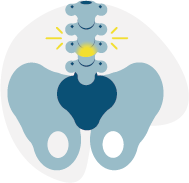Lumbalgia is low back pain that comes from the lumbar region, which is between the ribs and the buttocks. It is estimated that 80% of the world’s population will have low back pain at least once in their lifetime.
Acabar con el dolor es posible y nuestro equipo quiere ayudarle a conseguirlo. Dé el primer paso contactando con nosotros.
Madrid: +34 919 148 441
Barcelona: +34 936 090 777
Llevamos la excelencia neuroquirúrgica a Sevilla, ofreciendo servicios especializados en neurocirugía de columna y cráneo.
¡Llama al +34 955 277 751 o +34 633 143 686 para más información!
Lumbalgia is low back pain that comes from the lumbar region, which is between the ribs and the buttocks. It is estimated that 80% of the world’s population will have low back pain at least once in their lifetime.

Is one that produces intense pain at a specific time and requires treatment at that time to control the pain crisis, either with medication, physical therapy or surgery. The most frequent causes are sports injuries or herniated discs.
Is one that produces continuous lumbar back pain of less intensity but that gets worse over time and is usually related to degenerative spinal processes. This type of low back pain requires a good diagnosis of the cause of the pain, since that will determine which treatment is appropriate.
Below is a list of the main causes of this type of pain:
The last 3 are not very common and are not the first thing we expect to find upon diagnosis.
The symptoms of vary depending on whether it is acute or chronic:
Apart from this, depending on the underlying spinal lesion, the symptoms will have specific characteristics. This makes it very important to get the correct diagnosis in order to choose the optimal treatment for each patient.
The treatments for lumbalgia are as varied as its causes. With the exception of those cases caused by serious problems such as tumors, infection or rheumatic disease, in which we will treat the specific disease, in the vast majority of cases, the causes are musculoskeletal. Quite often, the low back pain that the patient suffers does not have only one cause, so getting the right diagnosis is essential, with the goal of choosing the right treatment.
The natural process of aging of the spine produces wear and degeneration of structures in the intervertebral discs, facets or ligaments, which together will cause muscle contractions that in turn will generate pain. The pain itself is almost always similar, but the internal cause will almost always be different, so it is of utmost importance to gather a complete clinical history and a combination of the right tests. When this information is reviewed by a spinal specialist, we can determine whether the lumbalgia is due to discogenic pain or facet pain, or another cause.

Discogenic pain is the one that occurs as a consequence of disc degeneration. Disc degeneration or discopathy is the term used for the process by which the disc alters its physiological structure and becomes unable to perform its function normally.
Facet pain is one of the main causes of lumbalgia. This pain originates in the facet joints, which are located in the posterior area of the vertebrae. Facet joints are synovial joints that have hyaline cartilage, synovial membrane, a fibrous joint capsule, and joint space. Like other joints, with the passage of time and the loads they are subjected to, they are prone to a process of degeneration.
In treatment of the spine, specialists usually go up a scale, step by step with the patient, offering from the most basic to the most specialized treatments. At first, we will start with specialized medication or rehabilitation.
If the patient does not improve with these measures, we will move on to the next step, which consists of pain clinic techniques such as infiltrations or rhizolysis. If these methods are not effective, we will consider surgical techniques for solving the patient's problem.
For people with lumbalgia who cannot undergo surgery for medical reasons or the patient’s pain is due to after effects of something that is irreversible, we can still resort to a last step in which we use functional neurosurgery with spinal stimulators or the implant of an internal morphine pump.
We will not necessarily have to pass through all the steps of the scale before finding the solution for our patient. In some situations, and at the discretion of the specialist, we will go directly to surgery if the problem requires it and it is likely to be beneficial for our patient. However, it is important to emphasize that 80% of lumbar problems can be solved with the first step, in which it is very important to get good medical advice and specialized rehabilitation.
Contact us so that we can give you a personalized assessment.